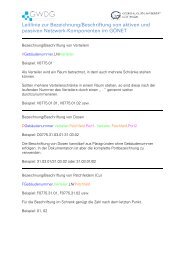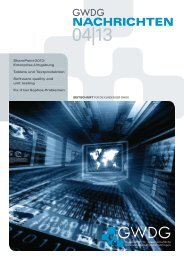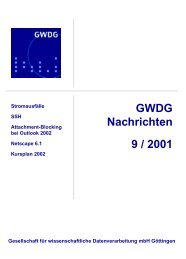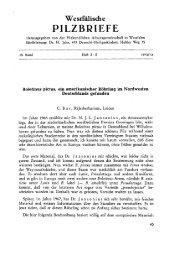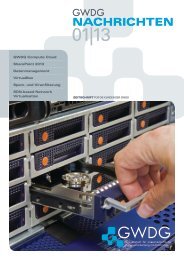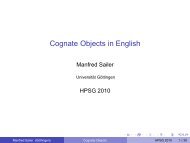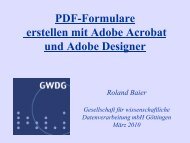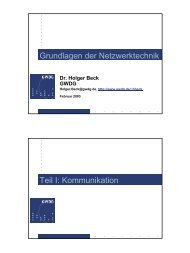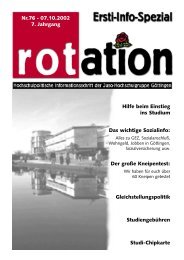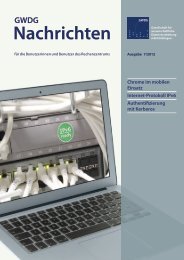Forschung und wissenschaftliches Rechnen - Beiträge zum - GWDG
Forschung und wissenschaftliches Rechnen - Beiträge zum - GWDG
Forschung und wissenschaftliches Rechnen - Beiträge zum - GWDG
Sie wollen auch ein ePaper? Erhöhen Sie die Reichweite Ihrer Titel.
YUMPU macht aus Druck-PDFs automatisch weboptimierte ePaper, die Google liebt.
automatic time step control. Although computationally more demanding, the<br />
latter are best suited for the most difficult stiffness problems e.g. associated<br />
with multiphase chemistry. For each individual application, it is necessary to<br />
balance the advantages and disadvantages regarding efficiency, stability, accuracy,<br />
and precision. We fo<strong>und</strong> that for most of our chemical mechanisms,<br />
the Rosenbrock solvers of 2nd or 3rd order (ros2 and ros3) work best. However,<br />
we stress that it may be necessary to test other solvers as well (e.g.<br />
radau5) to achieve the best performance for a given set of equations. Fortunately,<br />
switching between solvers is easy with KPP and does not require<br />
any reprogramming of the chemistry scheme. The selection of a chemical<br />
equation set and a numerical solver is shown in Fig. 6.<br />
4.16 OFFLEM<br />
MAINTAINER: Patrick Jöckel<br />
DESCRIPTION: This submodel reads input data from files for two-dimensional<br />
emission fluxes (i.e. surface emissions in molecules/(m 2 s)) and threedimensional<br />
emission fluxes (aircraft emissions in molecules/(m 3 s)) and updates<br />
the tracer tendencies (gridpoint- and Lagrangian) accordingly.<br />
4.17 ONLEM<br />
MAINTAINER: Astrid Kerkweg<br />
CONTRIBUTIONS: Yves Balkanski (LSCE), Ina Tegen (MPI-BG), Philip<br />
Stier (MPI-MET), Sylvia Kloster (MPI-MET), Laurens Ganzeveld, Michael<br />
Schulz (LSCE)<br />
DESCRIPTION: This submodel calculates two-dimensional emission fluxes<br />
for gas-phase tracers (i.e. surface emissions in molecules/(m 2 s)) and updates<br />
the tracer tendencies accordingly. In addition, aerosol source functions are<br />
calculated.<br />
4.18 PSC<br />
MAINTAINER: Joachim Buchholz<br />
ORIGINAL CODE: Ken Carslaw, Stefanie Meilinger, Joachim Buchholz<br />
DESCRIPTION: The Polar Stratospheric Cloud (PSC) submodel simulates<br />
micro-physical processes that lead to the formation of super-cooled ternary<br />
solutions (STS), nitric acid trihydrate (NAT), and ice particles in the polar<br />
stratosphere as well as heterogeneous chemical reactions of halogens and<br />
dinitrogen pentoxide on liquid and solid aerosol particles. Denitrification and<br />
dehydration due to sedimenting solid PSC particles are calculated for each<br />
grid box depending on particle size, pressure and temperature.<br />
25



